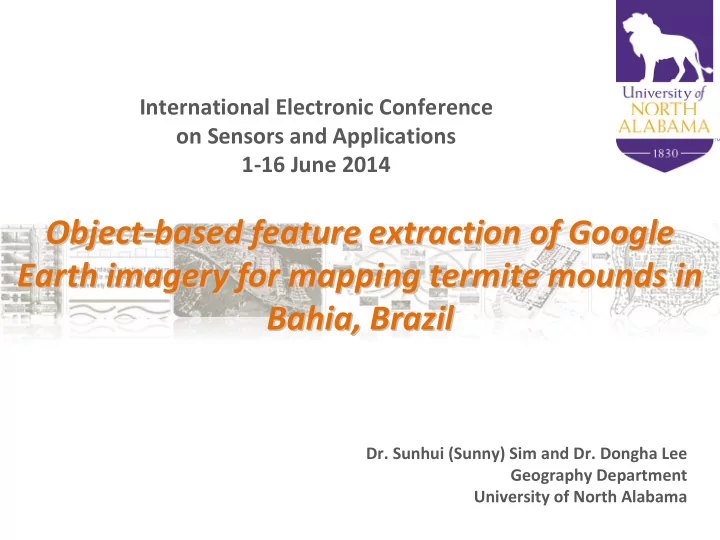

International Electronic Conference on Sensors and Applications 1 ‐ 16 June 2014 Object ‐ ‐ based feature extraction of Google based feature extraction of Google Object Earth i imagery for mapping termite mounds in magery for mapping termite mounds in Earth Bahia, Brazil Bahia, Brazil Dr. Sunhui (Sunny) Sim and Dr. Dongha Lee Geography Department University of North Alabama
Smarter Image Processing: Object ‐ Oriented Classification Traditional classifiers don’t work as well for new generation of high resolution data, like this 2 foot Emerge Color infrared airphoto. Why? Meaningless to classify each pixel
Object ‐ Oriented Classification • Problems with pixel based classifiers: – Extreme heterogeneity of small pixels (e.g. shading, multiplicity of colors within an object) – Two pixels with same spatial reflectance might be totally different types of objects/ features (e.g. building and road) – Two pixels with very different reflectance may actually be part of the same object type (e.g. building materials of different reflectance)
Termite Mounds • often hotspots of plant growth (i.e. primary productivity). Accurate and timely – Extreme heterogeneity of small pixels (e.g. shading, multiplicity of colors within an object) – Two pixels with same spatial reflectance might be totally different types of objects/ features (e.g. building and road) – Two pixels with very different reflectance may actually be part of the same object type (e.g. building materials of different reflectance)
Study Area and Data • Bahia, Brazil: one of the 26 states of Brazil, eastern part of the country on the Atlantic coast The actual testing site covers 0.77 square • kilometers and is at latitude of ‐ 12.47 and a longitude of ‐ 41.64. The remote sensed data used was captured • from Google Earth Imagery
Methods Imagine Objective in Erdas 2011 version and later versions provide solutions to object ‐ based image analysis • Step 1) Raster Pixel Processor: For this pixel based classification the SFP (single feature probability) was chosen, which uses a Bayes ‐ classifier. The definition of training areas for termite mounds is important for the outcome; • Step 2) Raster Object Creators: in this step, the function “Threshold and Clump” was used and assigns an average pixel probability (combined with results of step 1; • Step 3) Raster Object Operators: Using “Probability Filter” and “Size Filter” allowed keeping pixel objects with high probability and a certain amount of pixels only; • Step 4) Raster to Vector Conversion: with “Polygon Trace”, raster objects were automatically vectorised converting objects; Step 5) Vector Object Operators: In this step, the • vector objects are generalized which accelerates later processing; • Step 6) Vector Objects Processor: This function processes geometric and textural features of the Vector Objects and writes the probability value for each feature to each object in an attribute table. This involves specifying area, Axis2/Axis1 and compactness cues.
Methods/Results
Conclusion/Outlook • Nearly 90% of the total termite mounds was identified and extracted with the feature model • Large cluster of termite mounds have maximum 1122 square meters in size and 328 meters in perimeter, small cluster of termite mounds have 240 square meters in size and 72 meters in perimeter. Most termite mounds had an average compactness of about 0.7. • • The object ‐ based feature extraction model by Imagine Objective can be applied to further study areas. In most cases, only the training process has to be adjusted. The study ensured the capability inherent with an object based image • analysis using 3 visible bands ‐ Google Earth Image.
Thank You! Comments and Questions? Contact Info: Sunhui Sim ssim@una.edu Dongha Lee dlee2@una.edu
Recommend
More recommend